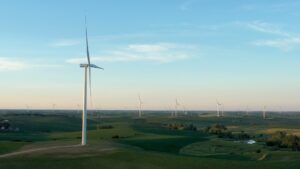We Can Grow the U.S. Wind Industry, but Effective Policy Is Critical
By Jérôme Pécresse
October 13, 2021

Wind power continues to play an ever-growing role in helping the U.S. decarbonize electricity production, an important part of addressing climate change. Last year, 41% of new electricity generation capacity in the U.S. came from land-based wind energy — more than from any other source — according to the U.S. Department of Energy.
We know there’s much more to do, but for wind to continue expanding, we need smart public policy that encourages sustainable, consistent growth. Historically, a key policy driver has been the Production Tax Credit (PTC)—a tax credit for building renewable energy that has played a critical role in spurring this growth. Knowing that growing wind is key, Congress is weighing a long-term extension of the PTC. A PTC extension is a clear positive for the wind industry but getting the details right is key toward keeping this positive momentum in the near term.
Given the urgency of climate change, we need to make sure that we are growing renewable energy—and a strong U.S. supply chain—every year, not losing momentum. In that sense, a long-term PTC extension also presents a challenge for the wind industry, as more than a decade of data shows that new wind turbine installations typically drop off dramatically in the first year or two following an extension year, delaying the build out of new renewable energy assets.
It goes without saying that such a decline would run against the urgency of achieving ambitious emission and clean energy goals and could have a negative impact on the U.S. supply chain, which relies on steady work.
Put simply: the growth of clean energy growth and U.S. jobs will be at risk if policy makers do not focus on the need for consistent progress for the industry in 2022 and the coming years. This needs smart policies that reflect the urgency of the need to steadily grow renewables today to counter the likely cyclical delays. Structuring the PTC so that it ensures steady growth each year is the critical first step. This will be good not only for renewable energy, but for maintaining the kind of stable supply chain and jobs that will be needed to bring a significant amount of new wind power online between now and 2030 … the very reason why a long-term extension of the PTC is being considered.
The onshore wind industry currently employs 120,000 Americans across all 50 states, including 26,000 wind manufacturing jobs at over 500 facilities. And the offshore wind industry that is just getting started in the U.S. is projected to create over 80,000 jobs by 2030.
At GE Renewable Energy we’re proud to have done our part. Last year, the American Clean Power Association (ACPA) recognized GE as the top manufacturer of wind turbines in the U.S. in 2020 – for the third year in a row. We’ve supplied the turbines for America’s first offshore wind farm ever and will supply the turbines for the Vineyard Wind I offshore wind project that will become the country’s first utility scale offshore wind farm.
As a key player in the U.S. wind market, we encourage policy makers to put in place reasonable policies that provide both long-term certainty and short-term stability in the wind energy market, rewarding projects that move quickly to advance our energy progress. Such an approach is the best way to maintain the momentum for the U.S. wind power industry – protecting jobs and the environment.
###
Join leaders from across the clean energy sector.

What will our next 20 years look like? Here’s the truth: they’ll be better with ACORE at the forefront of energy policy.
Shannon Kellogg
Amazon Web Services (AWS)
